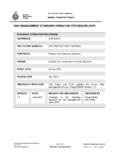Transcription of Executive CORPORATE SCIENCE, ENGINEERING AND …
1 CORPORATE SCIENCE, ENGINEERING AND ANALYSIS DIRECTORATE Human Factors, Ergonomics and Psychology Project Report RISK management OF MUSCULOSKELETAL DISORDERS IN SONOGRAPHY WORK Authors: Simon C Monnington1 Katie Dodd-Hughes Edmund Milnes Yasmeen Ahmad Date: 23 March 2012 1 HSE Government Buildings, Ty Glas, Llanishen, Cardiff, CF14 5SH Health and Safety Executive MSD risk management in sonography II Executive SUMMARY INTRODUCTION Healthcare professionals undertaking diagnostic imaging work using ultrasound equipment have a high prevalence of musculoskeletal disorders (MSD). There is a substantial amount of published information on MSD risk management specific to sonography.
2 However, it is not clear how this information translates into practice in the UK. This report describes a project to examine MSD risk management performance across a range of sonography operations at UK NHS Trusts. This report is aimed at healthcare professionals involved with sonography work, their professional bodies and trusts that employ sonographers and operate services. It is also aimed at manufacturers of sonography equipment and training providers. This report will also be of use to regulators and other health and safety professionals involved with the health service. MAIN FINDINGS Inspections of 14 NHS trusts in the UK were undertaken in 2007 to examine how effectively MSD risks were managed in sonography work.
3 Overall, performance was found to be much less effective than it should be. This is cause for concern because of the high levels of MSD associated with sonography professionals and the large amount of industry specific guidance in existence. The main issues were: Risk assessments generally weren t suitable and sufficient Despite widespread awareness of the MSD risks to sonographers, action to tackle the problems tended to be superficial Risk reduction and controls were generally not comprehensive enough to reach the so far as is reasonably practicable standard Workload was generally high in sonography. Work organisational / psychosocial factors were seldom sufficiently assessed and controlled, despite their apparent influence in reducing risk In most cases training did not adequately address MSD risks , and how to conduct best practice scanning Occupational Health provision, whilst generally good, tended not to be used proactively for sonographers Health monitoring was rare, even for individuals with established MSD problems Manufacturers and education providers have a key role in developing improved systems in sonography work.
4 Both should take account of and facilitate fundamental changes to current scanning practice Generally, the arrangements for sonography work could be improved which would improve efficiency as well as the health of sonographers. To deliver a sustainable, efficient and safe sonography service the human factors issues in sonography need to be tackled in a thorough and fundamental way. Improving standards Trusts should adopt the HSG60 seven stage approach for managing MSDs in sonography and across other specialist departments. The evidence strongly suggests that action is needed most in risk assessment and control. NHS trusts should provide the necessary resources to help all departments tackle their MSD risks effectively.
5 Efforts should be coordinated across all sonography modalities at a trust. Work organisation should be a central target. Increased sonographer control of their work should be considered as well as efforts to balance workload to enable rest breaks to be taken. Suitable changes to the physical environment like the introduction of slave MSD risk management in sonography III monitors can be effective. The potential of introducing fundamental changes in sonography practice such as scanning with both hands and making effective use of voice activated systems should be a priority. There is a clear role for equipment manufacturers and education providers in developing / facilitating improvements to sonography systems of work supported by feedback of users.
6 Further detailed actions concerning sonography work are contained in this report. MSD risk management in sonography IV CONTENTS 1 INTRODUCTION .. 1 Musculoskeletal disorders (MSD) in sonographers _____ 1 Key information on managing MSD risks in sonographers _____ 2 Project aims and objectives _____ 2 2 PROJECT 3 Checklist development _____ 3 Project briefing_____ 3 Project inspections _____ 3 3 INSPECTION FINDINGS .. 4 Awareness of MSD risks _____ 4 Occupational health provision _____ 4 MSD Monitoring _____ 4 Scanning workload _____ 5 MSD risk assessment _____ 5 Risk reduction and control _____ 6 Worker involvement_____ 7 Sonography workstation _____ 8 Education and training _____ 8 Patients with a high body mass index _____ 9 Other DSE work _____ 9 Professional and training issues _____ 9 Human performance _____ 10 Sonography equipment manufacturers _____ 10 Ergonomics and sonography education _____ 12 4 CONCLUSIONS.
7 13 5 Risk management approach _____ 14 Risk reduction and control measures _____ 15 Work organisational aspects _____ 17 Training and educational providers _____ 17 Manufacturers _____ 18 6 REFERENCES .. 20 APPENDIX 1 .. 21 SUMMARY OF AN EVALUATION OF MUSCULOSKELETAL DISCOMFORT EXPERIENCED BY SONOGRAPHERS (DODD-HUGHES, 2008) .. 21 MSD risk management in sonography V LIST OF FIGURES Figure Examples of sonography procedures and the range of awkward postures involved. Left, a vascular examination of the lower limbs giving rise to reaching, and twisting of the trunk as the sonographer applies the transducer with one hand and squeezes the muscle with the other. Right, an early pregnancy scan giving rise to extension and deviation of the wrist as the transducer is applied and finely moved to give an appropriate image on the screen.
8 _____ 1 Figure The range of scan times for various sonography modalities. _____ 5 Figure The distribution of assessment methods used in sonography departments. _____ 6 Figure Examples of poor standards of DSE set up in sonography consult rooms. _____ 9 Figure A ceiling mounted slave monitor positioned to be viewed by a patient laying on the couch. The US machine can be seen positioned at the side of the couch. _____ 15 Figure The scanease limb / tranducer support system. _____ 16 Figure A simple cable support that reduces loading at the wrist associated with cable sag. _____ 16 Figure Alternative design sonography system. _____ 18 Figure A small portable ultrasound machine used for ward based examinations. _____ 19 LIST OF TABLES Table Examples of control measures to reduce MSD !
9 Bookmark not defined. Table Worker involvement and MSD risk control RCI results. _____ 7 MSD risk management in sonography 1 1 INTRODUCTION Diagnostic imaging using ultrasound equipment is an effective and useful tool for a range of clinicians in the National Health Service (NHS). Ultrasound uses high frequency sound waves to produce a real time image of the internal body. These images are used to check function, look for abnormalities and take measurements and stills for the most part non-invasively. Three main professions do ultrasound work: Radiographers work in obstetrics, gynaecology and general ultrasound; Cardiac Technicians undertake echocardiography (the heart); and Vascular Technicians investigate blood vessels using ultrasound.
10 Midwives can undertake aspects of the obstetric work ( dating scans etc). Ultrasound equipment is also deployed in musculoskeletal investigations. Medical practitioners can also use ultrasound machines. Sonography work involves an operator guiding a handheld transducer against the patient s body while simultaneously monitoring a screen and using a keyboard to control / record the image. Musculoskeletal disorders (MSD) in sonographers Several studies have identified aspects of sonography work that were associated with MSD. These included (fig ): one-sided static working position; prolonged pinch gripping of the ultrasound transducer; abduction at the shoulder during transducer placement; and insufficient recovery time (Vanderpool et al, 1993; Magnavita et al, 1999; Schoenfeld et al, 1999; and Village and Trask, 2007).
















